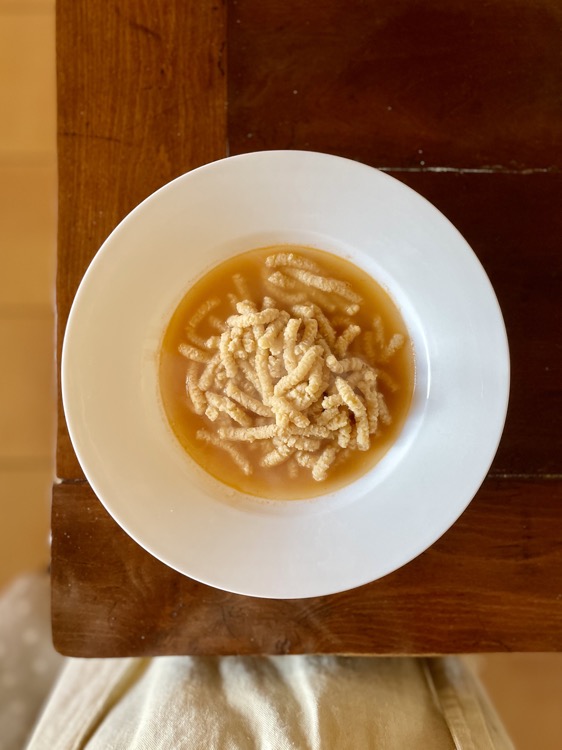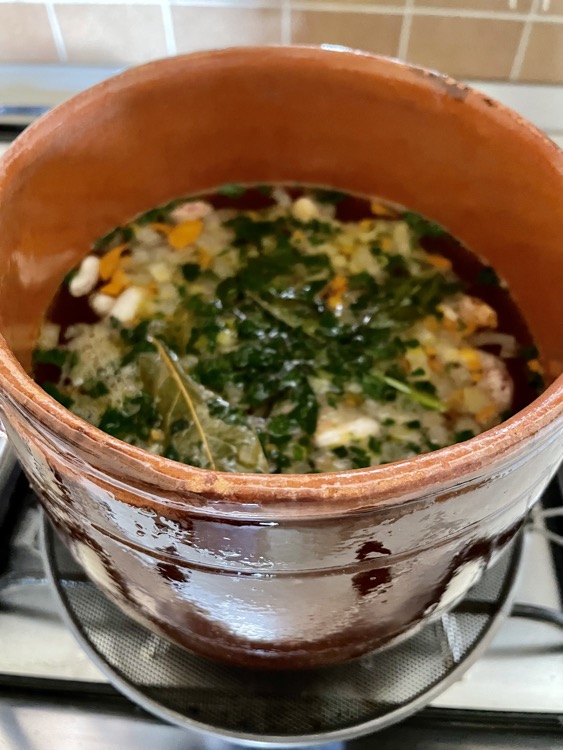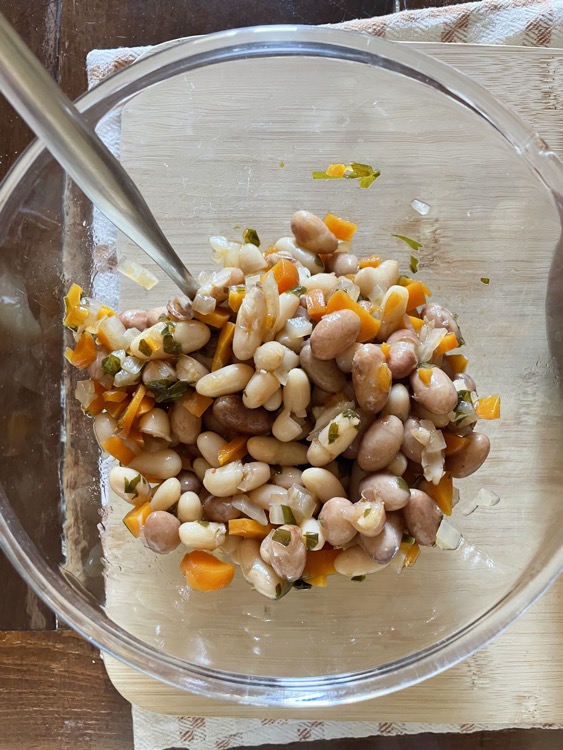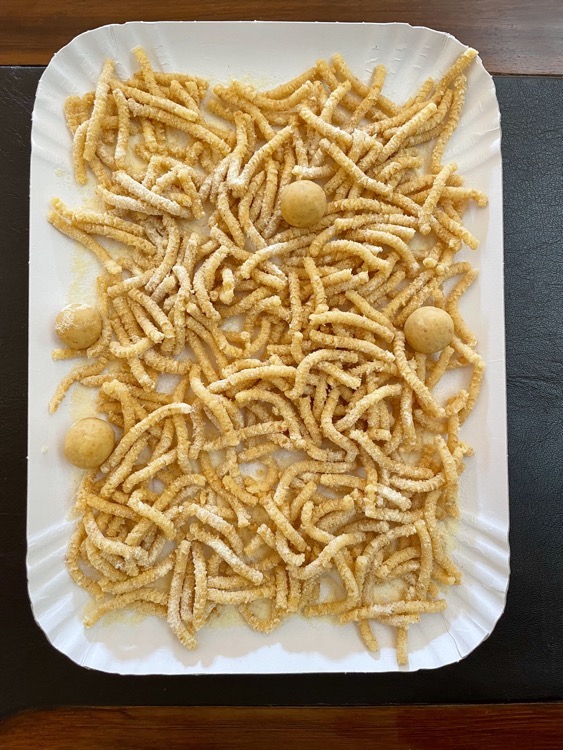Bean broth is one dish of Italian cucina povera that belongs to my family history and the area where I was born and raised.
It was the broth of peasants. Today it is a forgotten recipe that deserves new attention.
The pot of bean broth is vegetarian, gluten and lactose-free, and cheap.

Terroir, between poetry and pragmatism
There is a French word, terroir, which means territory but also the flavor of a place, and its characteristics are the combination of climate, geography (soil), and human effort.
Within the pages of Palomar, Italo Calvino writes about green Normandy:
“Behind each cheese, there is a pasture of a different green under a dissimilar sky: meadows encrusted with salt that the Normandy tides deposit every evening; meadows perfumed with aromas in the windy sun of Provence; there are different herds with their stabling and transhumance; there are processing secrets handed down through the centuries”.
Also chef Massimo Bottura, to remain on the subject of cheese, recently used the word terroir speaking of Parmigiano Reggiano.
Normandy cheeses and Parmigiano Reggiano, like any typical product, can only belong to one place, the place of origin, where the encounter between sky, earth, and man has created a unique and original flavor experience that cannot be reproduced elsewhere without losing its terroir, which, you may have guessed, also has to do with the very soul of people, places, plants, animals, and the earth (which is a living being).
A cooking project about my table, or perhaps I should say my terroir
I needed time to focus on my writing and cooking project.
At first, I published recipes that told my all-around passion for cooking and good stories, which is why you find clafoutis and club sandwiches on the blog.
Over the years, I realized that I wanted to tell above all about the traditional local dishes that have been part of my table and life since childhood.
I’m thinking about the recipes rich in flavors, such as lasagna and Bolognese ragu, that so many know and love, even abroad. But also traditional ingredients and dishes from the countryside that are often less known even to the locals. These simple and cheap tastes are mostly a forgotten heritage.
This journey through known and lesser-known flavors, recipe after recipe, has allowed me to rediscover aromatics, wild herbs, and flowers (have you seen my family recipe for herb and ricotta balls yet?); and to introduce new recipes from the cucina povera into the menu.

My Bolognese and Romagnola kitchen
I was born and raised on the border between Emilia and Romagna, and my gastronomic identity is a mix of them.
History teaches that the connection between Bologna and Romagna runs deep.
Both, until the unification of Italy, were part of the State of the Church.
And, of course, this shared history has left many traces, including at the table.
From this, it follows my Bologna-Romagna cuisine is not an anomaly.
On the contrary, it is my terroir and identity.
I feel like a product of my land, as if I were a local, wild herb or a cheese.
Bean broth
Like bean soup, the broth is also a dish that, despite significant territorial variations, belongs to the tradition of all of Italy.
Both are uncodified recipes that refer to oral transmission, typical of the peasant world. And for this reason, they are among the richest in family variations.
The cuisine repertoire of Bologna and neighboring Romagna share many peasant recipes that have legumes as protagonists: soups, purees, and ragù.
Nonna Sara often made bean soup. If there were some leftovers, adding more water, she would make a slightly thick and flavorful broth that she used to make minestrone.
Other times she used to prepare a smooth, strained bean broth that she would use to cook passatelli or fresh pasta such as maltagliati and tagliolini.
Still today, I make the pot as she made
I start with a soffritto of onion, carrot, and parsley. Then I add sage and bay leaves.
After some minutes, it is time to include the dried beans soaked in water the night before.
I use half cannellini and half borlotti, but you choose whichever you prefer.
The other ingredients are water, salt, and a generous tablespoon of tomato paste, only “to color the water,” as nonna used to say. But if you want a clear broth, omit the concentrate.
After cooking the beans in water, I separate the liquid from the solid part, filter with a sieve, and the bean broth is ready.
To make it thicker, I add some of the beans to the broth and then whisk. After removing the bay leaf and sage, use the beans for other preparations such as veg burgers or balls.
That is vegetarian, gluten, and lactose-free. Hearty but delicate.
You can use it for cooking pasta or vegetables.
Or for passatelli, as I made.
Buona cucina, Monica
Cook with me
If you love legumes on the blog, find the pea puree and the lentil and chickpea sauce for pasta recipes.
Keep in Touch
- To receive unpublished recipes, tips, and food stories, sign up for the Tortellini&CO newsletter.
- Follow me onInstagram, Pinterest and Facebook.


Bean broth recipe
serves 4
List of the Ingredients
1 l abundant water
140 g boiled beans
1/2 onion
1 carrot
chopped parsley, 5 g
a few sage and bay leaves
olive oil, a knob of butter and salt
optional: 1 generous tablespoon of tomato paste
How to make passatelli: here.
Method
Peel onion and wash carrot and herbs.
Finely chop carrot, onion, parsley, and sauté gently in a pan with olive oil, a little butter, and salt.
Combine boiled beans, sage, and bay leaf, stir, and cook for two minutes.
Add water, concentrate, and stir.
Bring to a boil, lower the heat, and cook on medium-low heat for 35-40 minutes.
Turn off, let cool for a few minutes, and use a slotted spoon to remove beans and herbs from the broth. Remove sage and bay leaf and put half the beans in the broth. Save the other half for other preparations such as croquettes or bacon and bean sauce to dress pasta.
With an immersion blender, blend the broth and strain.
I like the broth well strained, but if you prefer it more rustic, go your own way.
Taste and adjust the salt. Bring the broth to a simmer, cook the passatelli in the bean broth, and serve the dish hot.
With an immersion blender, blend the broth and strain.
I like the broth well strained, but if you prefer it more rustic, go your own way.
Taste and adjust the salt. Bring the broth to a simmer, cook the passatelli in the bean broth, and serve the dish hot.



